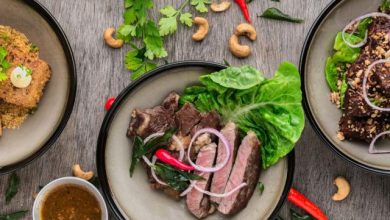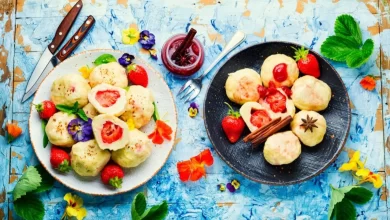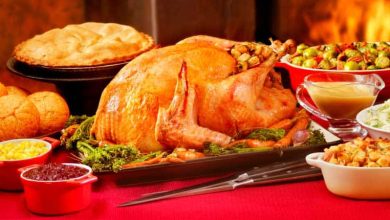Malaysian cuisine
This is not entirely true. Just the traditional cuisine of Malaysia consists of interweaving and borrowing from the cuisines of various peoples: Chinese, Indian, Thai, etc. You can even find dishes borrowed from the Portuguese.
At the same time, here you can find purely traditional cuisines of the peoples living in the neighborhood: Thai cuisine, Indonesian, Indian, Chinese, and others. Worldwide fast food chains, incl. Macdonald’s, Pizza Hut, etc., where you can eat familiar European food.
As in all of Asia, rice has become a staple food in Malaysia. Rice is present as an ingredient or side dish in almost all dishes served in restaurants and cafes in Malaysia, unless, of course, it is McDonald’s. Rice can be seen here in all sorts of widows and in all sorts of forms. It is served with any dish as a side dish. It is mixed with spices, spices and coconut milk. They even make desserts with it.
In the same way, rice is also indicated in neighboring Indonesian cuisine. All other products here are called by the same name “laud” (laud), which literally means “addition to rice.”
A variety of tastes of the same product, a bright and rich taste, sometimes even tasteless at first glance, ingredients are given by spices. Among them are various mixtures of curry, chili, garlic, ginger, galangal, lemongrass, kaffir. Coconut milk used in cooking gives a special taste to simple dishes. Often, coriander, cumin, cloves, cinnamon, cardamom, anise are used in cooking.
Traditional Malay dishes are never made with pork as the majority of Malays are Muslims. Usually, chicken, fish, lamb or beef are used as meat.” Also in the diet of the Malays, many dishes are prepared using seafood.
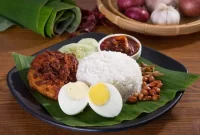
For lovers of vegetarian food in Malaysia, a whole “Klondike” of tastes and new sensations will open. The country has a chain of Buddhist vegetarian restaurants “Banana Leaf”, offering South Indian cuisine. In these restaurants, not only the dishes themselves are interesting, but also the ceremony of eating without cutlery and unnecessary conventions.
Despite the fact that the main traditional dishes throughout the country seem to be the same, and are made from the same basic products, in fact, in different regions of the country, their taste will differ significantly. Moreover, even in the same city in restaurants of different ethnic groups or regions, the taste of the dish can also vary greatly.
So, for example, in the north of the country, closer to Thailand, the influence of the northern neighbor is felt in the dishes. When cooking in large quantities, lime, kaffir, lemongrass are used, which gives the food a sour tint and citrus flavor of Thai dishes. On the southwest coast, the Indonesian island of Sumatra has an influence. As a result, the dishes here acquire a spicy-spicy taste.
In a fairly decent café, you can get enough for 15 RM (Malaysian currency) per person, and if you limit yourself to traditional dishes, such as, for example, Nasi Goreng, Roti Chania, etc., then you can spend RM15 for two. Don’t believe? Look at the prices on the photo in one of the cafes in the center of Kuala Lumpur (click on the photo to enlarge) taken in October 2011.
Of course, you can find an institution for any budget, and leave several hundred dollars for a lobster or crab for one dinner. Prices in hotel restaurants are usually quite high, and it is much cheaper to eat in establishments located outside the hotels.
What is even more surprising, sometimes in cheap-looking street cafes, consisting of a tray and a plastic table, you can get a pretty decent amount for a modest dinner if you don’t inquire about the cost of the dishes in advance. It is best to look at the menu with prices in advance, and then order.
To taste real Malaysian cuisine, you need to eat at least once from hawkers on the street or at a café where locals eat. You can eat to satiety in such a place on the RM5. Do not be afraid to eat from the trays: the food on them is clean and safe for a healthy stomach.
Food hygiene is given great attention here, which is forced by the hot climate. Food is prepared right in front of you from fresh ingredients. No reheated food, everything is fresh. If you have a weak stomach, it is better to approach this issue with all caution or not risk it at all and eat in European establishments.
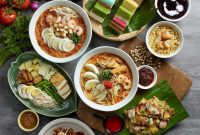
In general, very often the cost of food in Malaysia is compared with the cost of food in Thailand and Indonesia. So in Malaysia, food will cost you a little more, by 20-30 percent, than in Thailand. Food in Indonesia is generally considered one of the cheapest, and here the difference will be about one and a half to two times.
Many popular dishes in Malaysia are borrowed from other cuisines in their pure form. Among them are the Indonesian Nasi Goreng and Rendang, Thai Tom Yum soup. Here is a list of popular traditional Malaysian dishes that you should definitely try out:
Nasi Lemak – rice cooked in coconut milk. Served with boiled eggs, anchovies, cucumbers, roasted peanuts.
Nasi goreng – fried rice with pieces of meat, shrimp, eggs and vegetables. Taha goreng – fried soy flour cubes fried with soy shoots, spicy seasoning and breaded ground peanuts.
Gado gado (Gado gado) – vegetable salad with peanut sauce, coconut milk and hot peppers, as well as soy sprouts and bamboo shoots.
Satay ayam or simply Satay is chicken skewers with sweet and sour peanut sauce.
Ketupat is rice fried in palm leaves with spices.
Ekor is a spicy buffalo tail soup.
Roti Chanai or Roti Jala (Roti Canai) Malaysian dessert pancakes. They are found in a simple form, like tortillas that are served with sauce and can be used instead of bread. But much more interesting with a filling of meat.
vegetables, fruits or cheese. Some varieties: Roti Chanai Ayam (with chicken), Roti Chanai Banana (with sweet banana filling), Roti Chanai Cheese (with cheese).
